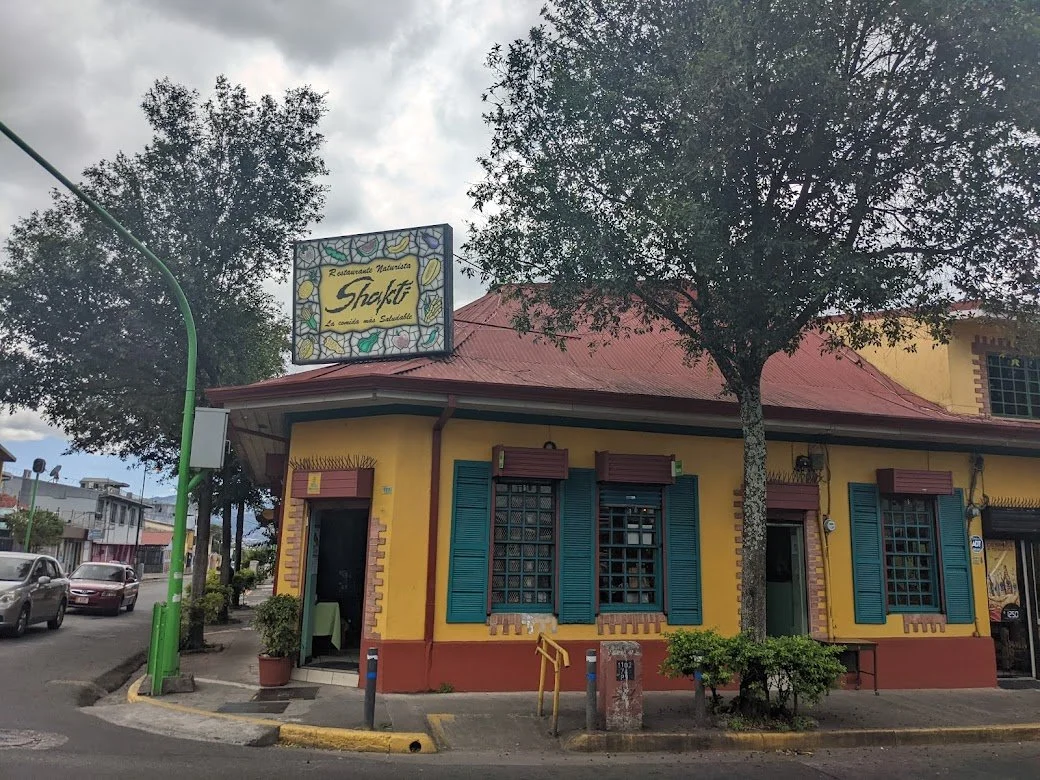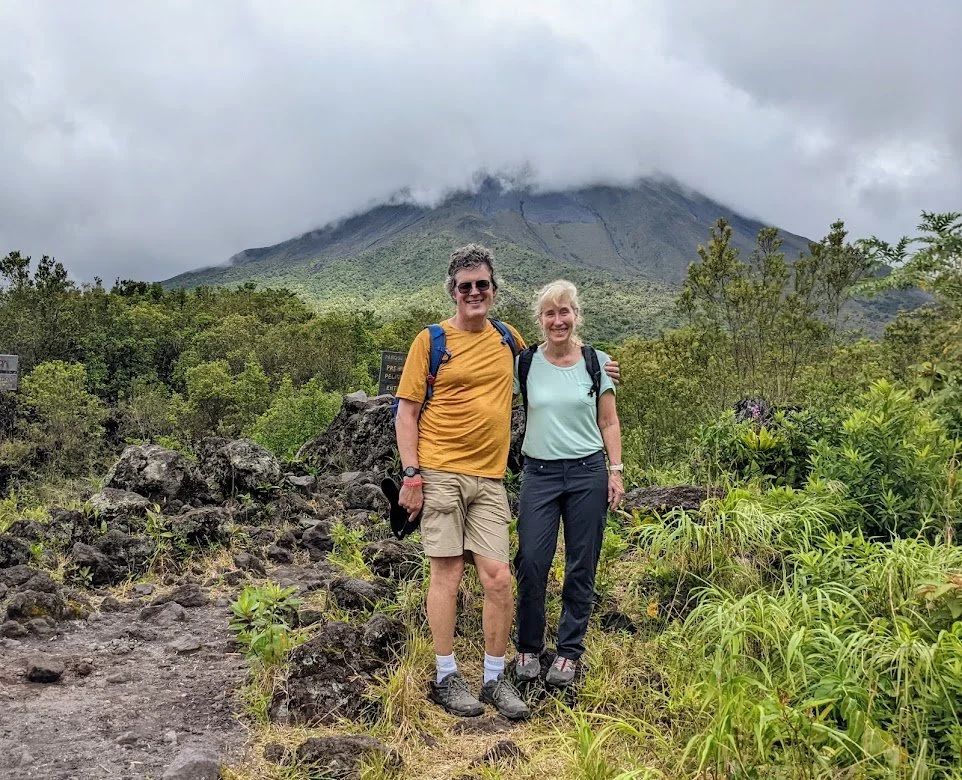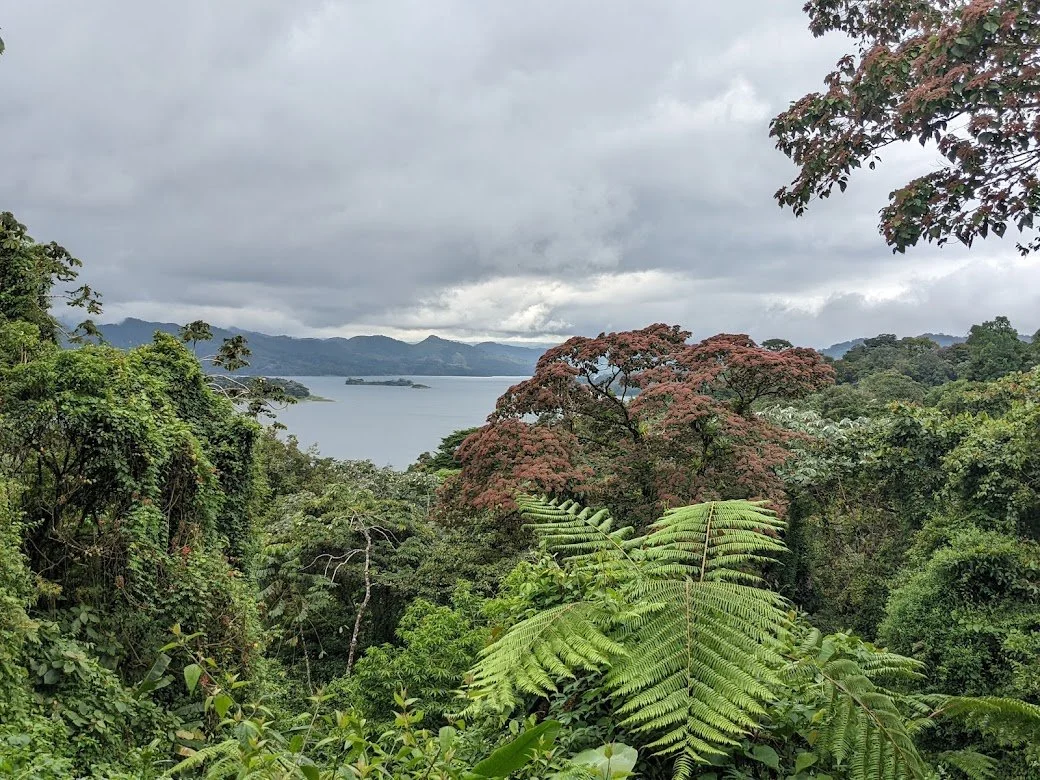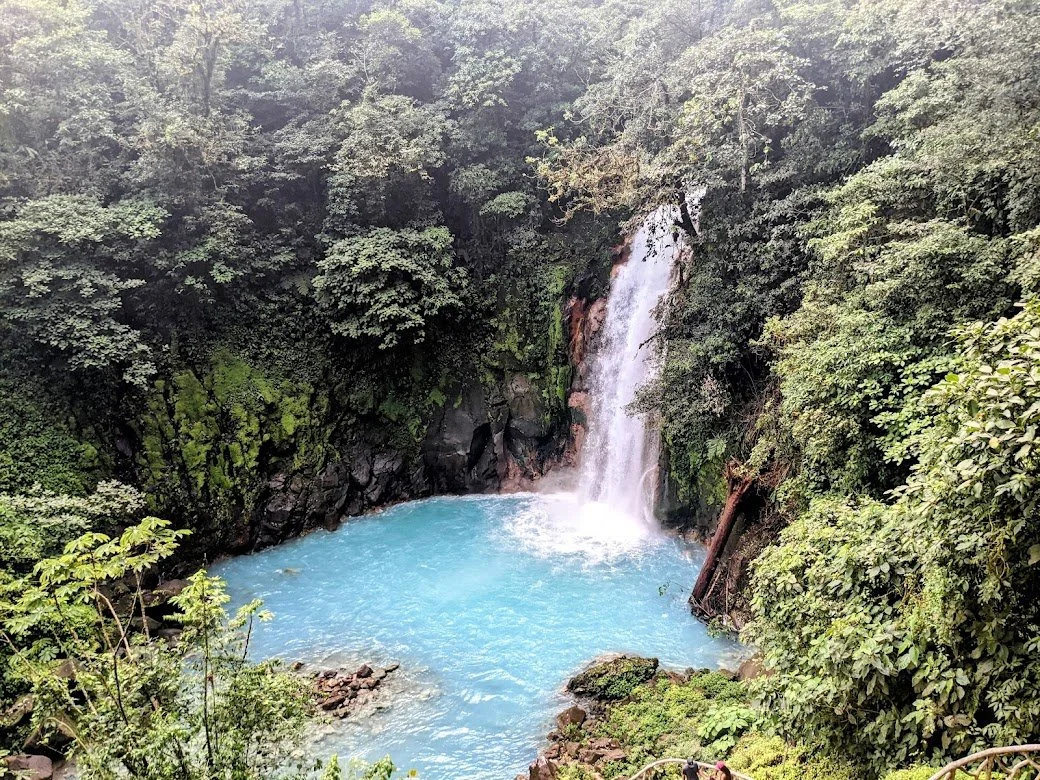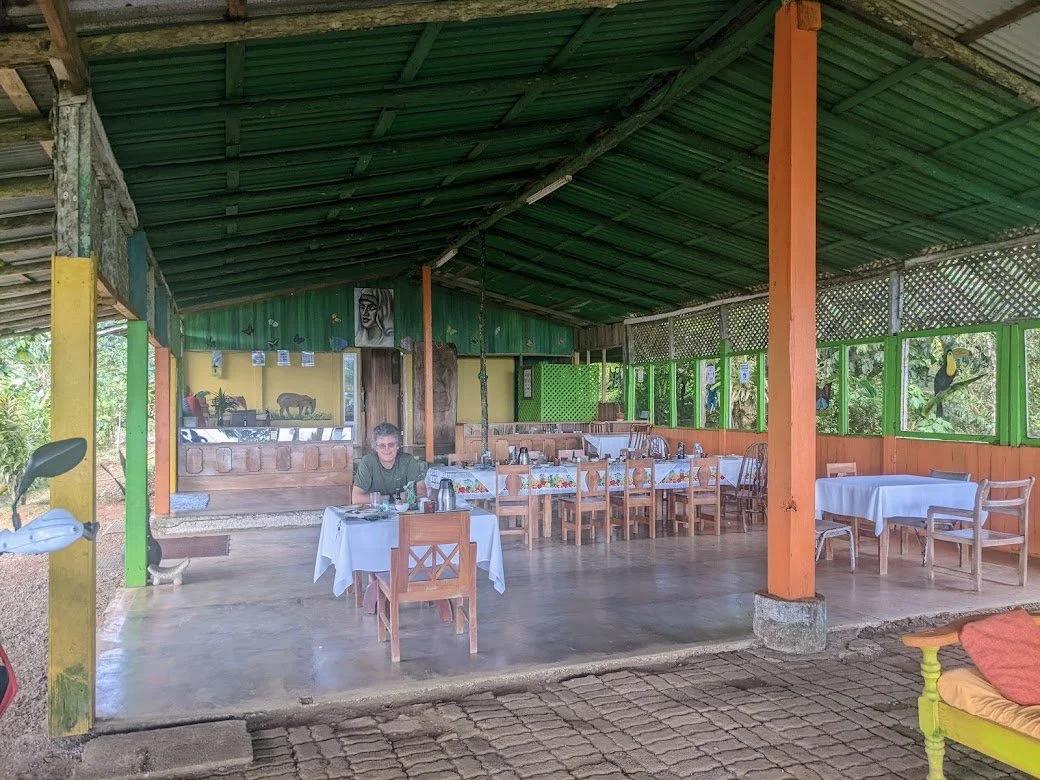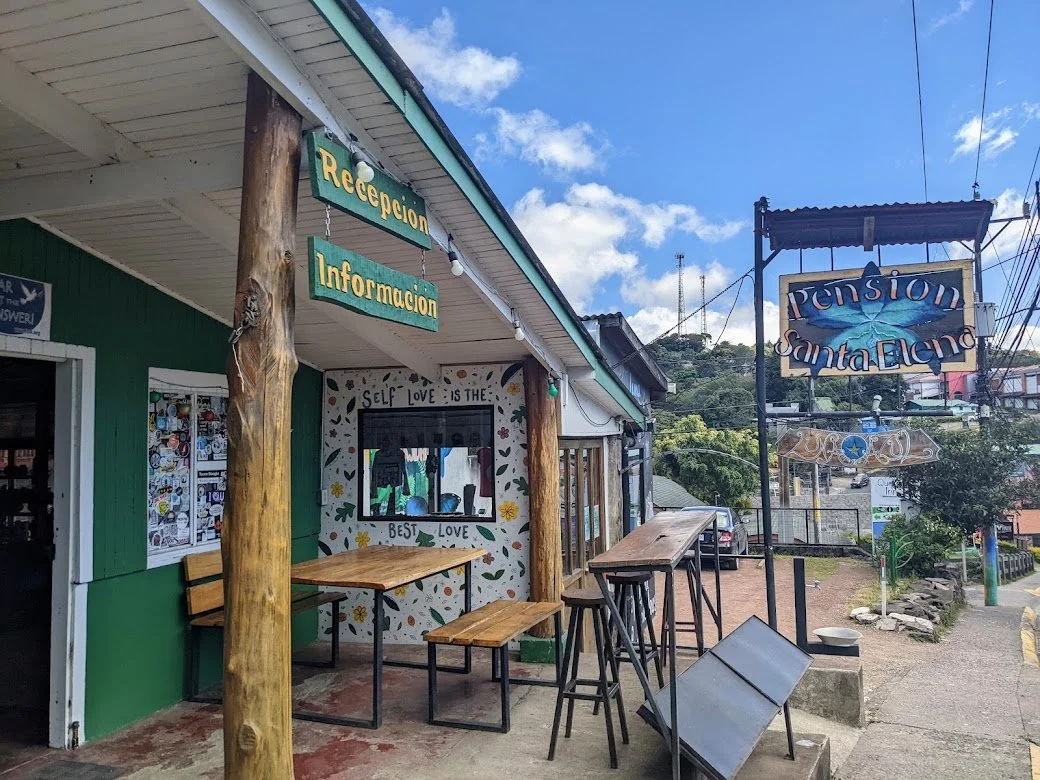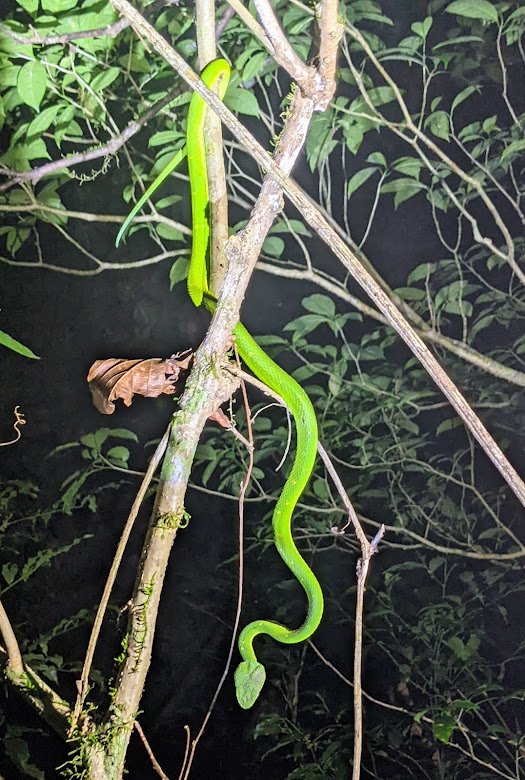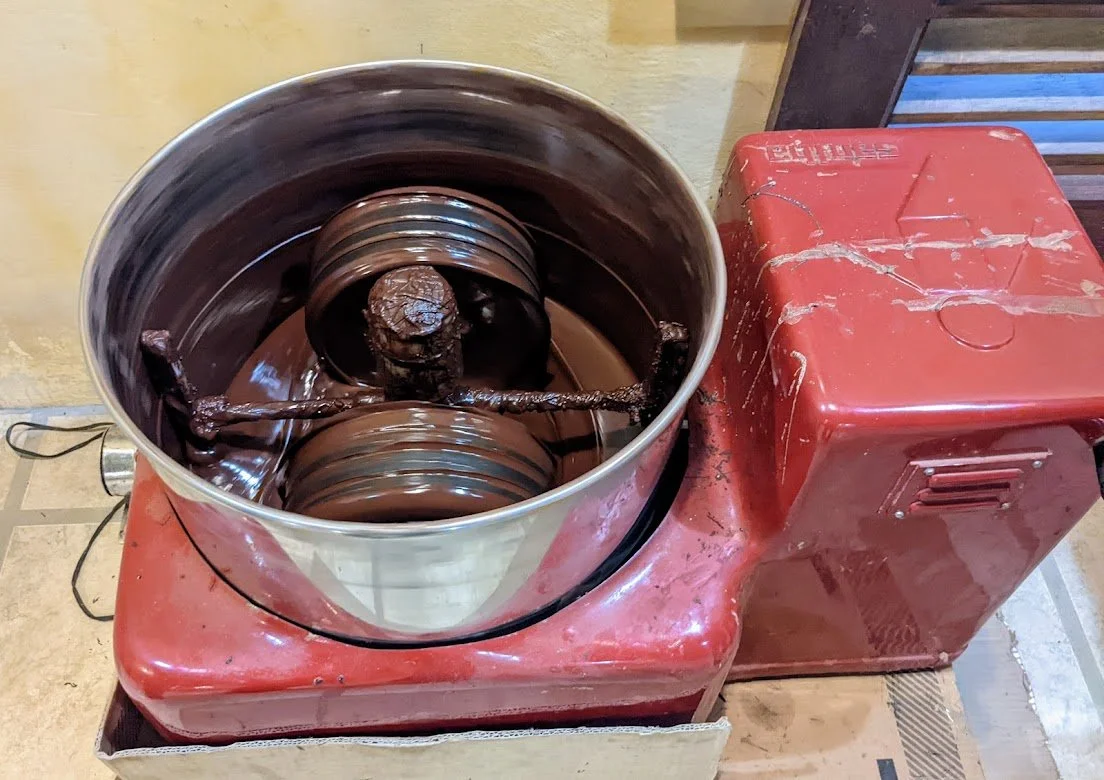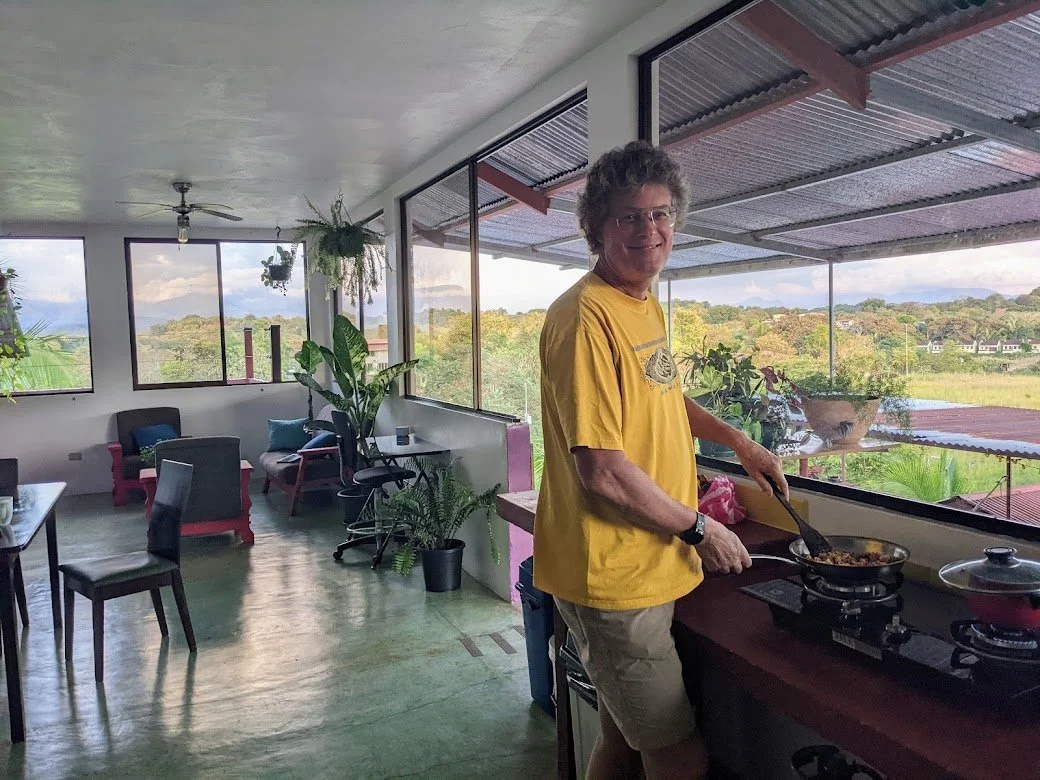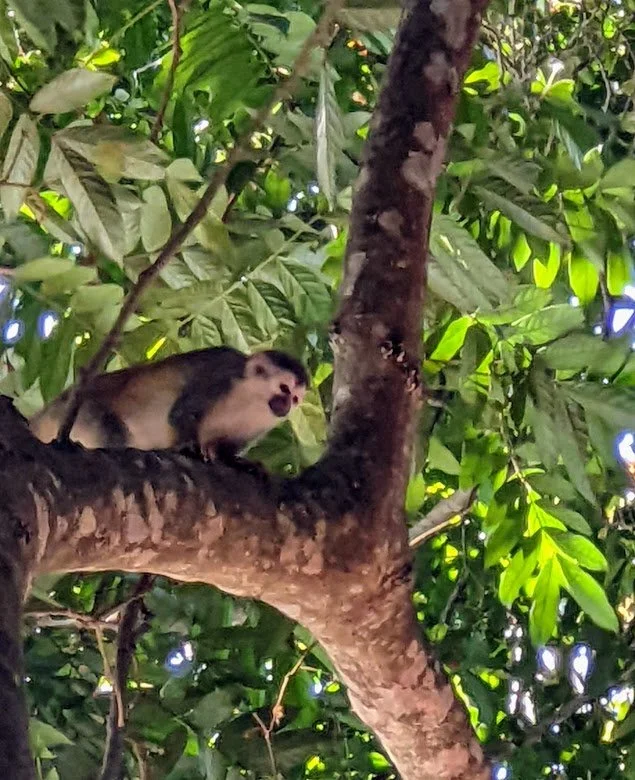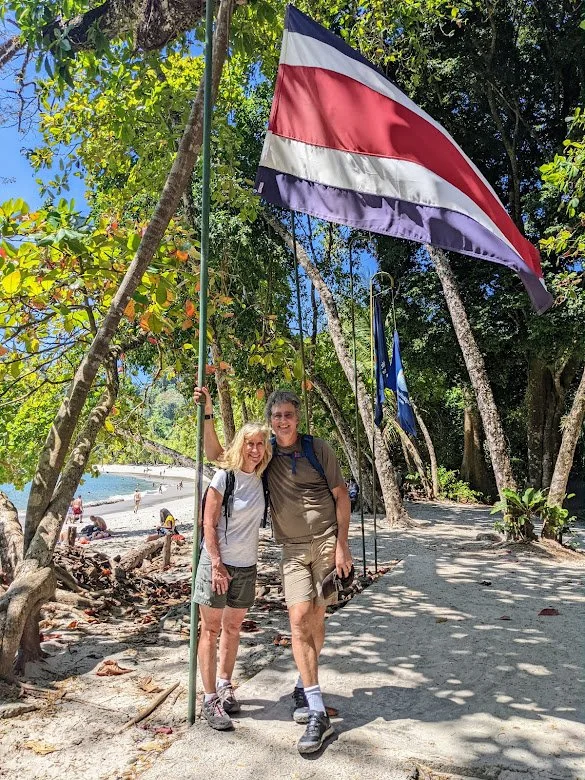Costa Rica - Part I - San Jose to Pacific Coast - Manuel Antonio
Arenal Volcano - almost peering out of the clouds
Spoiler alert- no truck photos in this blog. We miss our home on wheels dearly, but left it behind in England and came to Costa Rica for five weeks to wait out the cold UK winter before we return to camper life. So here we are, driving around in a tiny cheap rental car, doing our best to avoid four-wheel-drive roads and wet river crossings - at least until we return with the truck in the future.
Costa Rica is a spectacular landscape of lush rainforest, majestic volcanoes and endless sandy beaches. We wake up to the thrumming sounds of howler monkeys, chirping parrots and squawking scarlet macaws, green skittish lizards crawling on the hotel walls. And then some days we wake up to jake brakes from the trucks going by, scooters squealing in the streets and dogs barking. Staying nightly in hotels is an adjustment for us and we miss having our own space day to day. But inexpensive accommodations are relatively easy to find in Costa Rica so we have been able to keep costs down.
Our driving route for the first 17 days. With a goal of seeing as much of the country as possible in 5 1/2 weeks, we kept moving (as we always seem to do)
San Jose
We flew into San Jose and spent a few days exploriing the city. We were suprised how walkable it was - we enjoyed exploring the lively downtown area filled with local shoppers surrounded by an eclectic mix of architecture.
As usual in a new city, we spend our first morning on the Free Walking Tour, learning about the history and culture of the city and country. Our guide explained Costa Rica’s national pride and confidence in disbanding the military in 1949 after a violent political civil war. Instead investment was made in three promises to the people: a minimum wage and 5 day, eight hour work week, free national healthcare (paid for by a 10.5% tax on all wages and a 13% sales tax) and public access to higher education - which led to the establishment of the University of Costa Rica. Nice!
The city is relatively new with much of it built in the 1960’s so you do not feel the sense of history that many other major cities have, but there is still plenty to catch your eye.
San Jose’s most famous building, the Teatro Nacional built in the late 19th century, financed by an export tax on coffee
New and old legislative buildings side by side in San Jose
The mountains are never far out of sight in San Jose
There is artwork and sculpture on display throughout the city center
The lively Avenida Central - the main pedestrian shopping street
More city art, and another Where’s Waldo moment - spot Andy
Our first stay - Hostel Shakti - $30 US for a night for a private room with bathroom. It was spacious with friendly staff, the only downside the commuter train that ran outside our bedroom window starting at 4am on weekdays.
Included was a marvellous cooked breakfast in the cheerful adjacent restuarant
A visit to the bustling San Jose Central Market where you can buy just about anything.
Some examples of older architecture - typical line of people waiting at the ATM on a Saturday
Beautiful abandoned old building downtown - our walking tour guide explained that no one is taking on some of these older buildings
After a few days we felt saturated with city life, picked up our rental car and headed up to volcano country - about a three hour drive from San Jose.
Parque Nacional Volcán Arenal
Andy’s big tree photo - La Ceiba, on one of our Parque Nacional Arenal hikes
Parque Nacional Arenal was gorgeous - even though the majestic peak of Arenal did not want to peer out of the fog for us.
We paid our park fee ($15/person) and took advantage of the beautiful trails in the park, hiking about 6 miles.
Our only disappointment was the realization that park itself did not have an extensive trail network.
Many of the hikes in the area were in privately held business ventures. Throughout Costa Rica we noticed this as a theme. We appreciate that the Costa Ricans are smart entrepreneurs jumping on the economic opportunities to sell guided hikes and adventure opportunities to tourists. But we missed access to free public trails which were almost impossible to find when we just needed to get out and walk. We found that most of the national parks were beautiful and huge but had limited developed trails, typically they could be explored in a day (with some notable exceptions: Corcovada, Chirripo and a few others). Campgrounds are run privately.
La Fortuna
We spent the night in the small town of La Fortuna, filled with restaurants, bars and friendly travel agents.
View from our hotel - the Downtown Fortuna Hotel - great location and value at $35 a night - deal on Booking.com
View up the main boulevard of La Fortuna towards Arenal
Parque Nacional Volcán Tenorio
Two hours farther north, we headed into our next volcano park. The famed blue waters of the Rio Celeste did not disappoint. We paid our $15/person fee, declined the help of a guide and hiked the four miles of trails to the waterfall and hot pools - mountain views made a gorgeous backdrop. We were glad to start our hike in the afternoon after many of the tour groups had left the parking lot.
Cabinas Piuri, close to the park in a garden like setting. Great value at $30 a night, rooms starting to see a few construction problems with sagging walls and broken tiles, but it was a deal and the location was perfect for us.
Another beautiful cooked breakfast - this time on an outside terrace.
Private river swimming at Cabinas Piuri
Scenic drive from Tenorio to Monteverde, Arenal in the background
This car is really not as good a model as our Tacoma
Monteverde
We chose to drive the three-hour scenic lakeside scenic route through Rio Chiquita which definitely put our little car to the test. We were also discovering that Google drive estimates in Costa Rica were heavily optimistic and did not take into account factors like wet river crossings or roads turning from paved to gravel with car swallowing craters at a moment’s notice. We bumped our way along, and the views made up for the scary moments about whether or not our car was actually going to make it up the mountainous roads.
Similar to La Fortuna, Monteverde is set up for tourists. Easily walkable with restaurants, hotels and tour agencies galore. Every adventure you might want at your fingertips - from ziplining to rafting to wildlife encounters.
We stayed in the Santa Elena Pension which we would highly recommend - clean and practical, $40 a night for a private room and bath for the two of us, including breakfast.
We had visited Costa Rica briefly a few years ago and spent time in the Monteverde Cloud Forest Reserve so opted to seek out some other opportunities this time around. Our first adventure - a night walk in the jungle.
For $25 each we signed up with Santamaria Nightwalks for a three hour exploration by flashlight. Our guide was fabulous and explained that the land we were on was a family farm and that the night walk trail was a business opportunity for them that was integral to keeping the farm. It was a fascinating experience to see the forest at night. Of course, we had been hoping for a sloth sighting but the animals don’t always cooperate with human desires.
Green viper hanging out next to the trail. Something wicked this way comes.
Tarantula - they are out there. They come out at night . . .
We went to two additional reserves to hike - during the day. Bosque Eterno de Los Niños ($15 each) and the Santa Elena Cloud Forest Reserve ($16 each). We loved the founding story of the Bosque Eterno de Los Niños - preserved because of the fundraising of children around the world - but the area open to the public was a much dryer and smaller forest.
The trails at Santa Elena felt more like a deep, wet cloud forest. We also appreciated the lack of people - very different than the more popular and sometimes crowded Monteverde Reserve.
Swinging bridge at Santa Elena Cloud Forest Reserve. Monkeys galore but we didn’t get a good picture of them.
So our other favorite activity alongside hiking, is eating. The area is known for chocolate, so we headed off to a chocolate tour ($18 each for what ended up being a private tour). We spent three enthralling hours with Chocolate Bob at Cabure Chocolate , a passionate and dedicated connoisseur of making pure chocolate of the richest variety. We received a deep dive into the whole process - from the complicated sourcing the dried and fermented beans (apparently there is no formalized standards or unity across farmers for how to do this so quality is frustratingly uneven) to the roasting, shucking and grinding that results in the pure chocolate liquer.
Grinding the cacao beans
Setting the chocolate - we made and ate our own chocolates with Bob’s guidance.
Budget
A quick aside on budget. Without our camper truck, we made the tradeoff to stay in budget accommodations but saved a ton on gas. In general, traveling in Costa Rica is less expensive than in the US but costs are rising and it is not as cheap as we had hoped.
It is definitely interesting for us being budget travelers at our age - being full-time travelers with no home to return to, daily expenses become more of a factor. Two things we try to avoid though are shared dorm rooms and bus travel. We really appreciate having our own transportation, so we invested in a rental car which became about a third of our total budget.
We budgeted $40 a night for hostels and hotels and were able to stay close to this. For us, when the price was closer to $30 the accommodations generally felt more run down and sketchier than was comfortable for us. When we stayed in hostels, we booked private rooms, but definitely took advantage of cooking in the communal kitchens. We budgeted $30 a day for food between groceries and restaurants and actually came in a little under but it took some work (lots of rice and beans). With breakfast generally included, we typically ate out once a day. Family restaurants known as Sodas are everywhere, with plates of rice, vegetables and meat (casdadas) running $5-7 a meal. Although we were on the move most days, we didn’t drive far, so gas ran about $7 a day.
The place where we blew the budget was money spent on National Parks, admission to reserves and tours. This ran about $20 on average per day for the two of us.
To the Pacific Coast
Well, by now we had been in Costa Rica for over a week and hadn’t seen the ocean. Time to fix that. We got back in our car and made our way four hours over to the northern Pacific coast - Playa Tamarindo.
Stopped at Llanos de Cortes waterfall, just outside of Liberia. Beautiful falls and swimming hole, refreshing mid point on the drive from Monteverde to the coast. $12 each park entrance
Pacific Coast Beaches
Playa Tamarindo
Playa Tamarindo was not our favorite town - the beach was lovely but it was a backdrop to bustling main street filled with tourist shoppers, bars and we saw no evidence of actual Costa Ricans living there. Restaurants seemed overpriced. But we are not surfers and for those with the passion for the waves everything else is likely irrelevant. We were also only there for one day so are absolutely willing to accept that we may have missed the hidden charms.
We dined in the outside food court near the beach at Playa Tamarindo- lovely and budget friendly
But as we headed south, the beaches became more remote and beautiful and the towns more rural with a mix of tourists and locals taking advantage of the natural beauty. We stopped in sleepy Playa Nosara and Playa Samara, with endless stretches of white sand and blue ocean and made our way to Montezuma.
Playa Nosara
Relaxing into daily beach walks.
Playa Samara
Although the photo doesnt do it justice (we backed into the photo after blasting through the water), unexpected river crossings created drama for us in our urban rental
Howler Monkey at the Cabo Blanco Reserve, a thirty minute drive from Montezuma, beautiful hiking
Monkeys! Not part of our daily life usually, in Costa Rica they provided endless entertainment. We were able to find and watch all four of the species living here. We loved hearing the Howler monkeys in the distance, and then finding them resting overhead. It never got old to hear the crashing through the canopy as monkeys approached while we were hiking. At different times, we watched the antics of the Capuchin monkeys bickering with each other, the graceful Spider monkeys moving athletically through the trees and the tiny Squirrel monkeys flying from branch to branch.
We loved our daily cooked breakfasts included with accommodations, always some variety of eggs and rice and beans. Although after five weeks of rice and beans for breakfast we were ready for a change.
We used Montezuma as a base to visit the surrounding towns and beaches. The town itself was barely more than a small crowded collection of restaurants and hotels on a small beach, but the location was ideal. It gave us easy access to the beautiful Cabo Blanco reserve at the southern tip of the peninsula and a variety of beaches. Accommodations in nearby Playa Carmen and Santa Teresa were way more than our cheap Downtown Montezuma Hostel which was the best value in area. We had a spartan rooms with a hard working fan, no towels provided and the communal kitchen a little scary but were provided with a hearty breakfast and good taking off point for exploring the coast.
Central Montezuma Plaza
For day trips, we walked beaches. Our first was Mal Pais, a tiny and humble village with almost no infrastructure. Next, we hit Playa Carmen which was obviously growing in tourism infrastructure. It was the beginning of a booming area bleeding into Santa Teresa. This region felt like it was being developed as a magnet area for digital nomads - young people from around the world flocking here for beach fun.
Santa Teresa was bustling, full of interesting restaurants but still didn’t seem as mainstream commercial as Playa Tamarindo. It had a lively mainstreet where ATV’s, scooters and motorbikes battled with pedestrians, buses and trucks. Gorgeous beaches lined the coast. We were drawn to the atmosphere of the area.
Our final beach walk was Playa Hermosa – which lived up to its name and was our favorite beach in the area, remote and stretching for miles.
Mal Pais Beach
Playa del Carmen
Santa Teresa Beach
Sideways surfboard on scooter, almost wiped out unwitting pedestrians
Mainstreet Santa Teresa
Playa Hermosa
Final day in Montezuma, did a short hike into a waterfall with a refreshing swimming hole
After a few nights in our basic hostel in Montezuma, we splurged on a night up the hill at Finca de Los Caballos, a beautiful hotel on the way to Paquera where we would catch the ferry to Punta Arenas. The Finca had air conditioning, a comfortable bed, soft towels, hot water and four pillows on the bed. Bliss for $60. We are at least a few decades older than many of our fellow guests when we stay at hostels, it has been an interesting experience for us - everyone is kind but we are sure they are wandering what the heck we are doing there.
Passing another ferry on the Paquera/Punta Arenas route
Driving from Punta Arena to Jaco we stopped at Crocodile Bridge. Yes its touristy, but, crocodiles!
Dawn’s “art” shot with the shadows of the two of us on the bridge looking down at the crocs.
Our next base was the town of Jaco, another bustling beach town, more dated than Santa Teresa and with rare (for Costa Rica) high rises along the beach.
Some jungle walks in the nearby national park
What if everyone just did this, no more rules needed!
Jaco Beach (facing away from the high rise buildings and hotels)
Our Jaco accommodation, Casa Jungla, bright basic hostel, $40 for a private room and bath and a lovely outdoor kitchen and garden
Parque Manuel Antonio
Our final stop on this blog installment, the most famous and visited national park in Costa Rica. For good reasons! Beautiful beaches and trails and tons of wildlife.
Our budget hostel - Villas Jacquelina in Quepo. As a more expensive area, it was $40 for a room with two twins, two pillows, and a shared bath.
But the most beautiful shared kitchen with great views
Our host Esteban at Villas Jacquelinas set us up with a guide, one of two times in Costa Rica we would make this investment (later at Corcovado we would hire a guide, as it is required for entrance to that park). Although not required at Manuel Antonio, we thought that we would be more likely to find obscure wildlife with a guide. And we certainly did. Twenty minutes into the hike Roger had shown us at least five animals we would never have seen on our own. Cost was $50 each for a two hour walking tour and included park entrance.
Lizard at Manuel Antonio
Fruit bats
Capuchin monkeys put on a show
Watched the squirrel monkeys passing overhead
Sloth!!! Dawn’s favorite
That’s it for this blog! Part two coming up, heading down to Corcovado National Park, then through mountainous central Costa Rica and up the Caribeean coast. Thank you for reading, let us know if we can answer any questions. We know are travel style is not for everyone, we never stay anywhere more than two nights and “relax” is not in our vocabulary but if you are planning a visit, hopefully this gives you some ideas.








